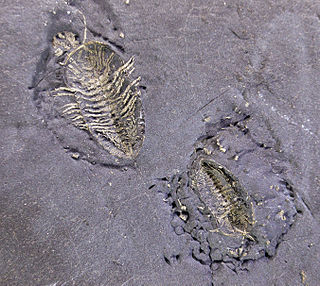
Beecher's Trilobite Bed is a Konservat-Lagerstätte of Late Ordovician (Caradoc) age located within the Frankfort Shale in Cleveland's Glen, Oneida County, New York, USA. Only 3–4 centimeters thick, Beecher's Trilobite Bed has yielded numerous exceptionally preserved trilobites with the ventral anatomy and soft tissue intact, the soft tissue preserved by pyrite replacement. Pyritisation allows the use of X-rays to study fine detail of preserved soft body parts still within the host rock. Pyrite replacement of soft tissue is unusual in the fossil record; the only Lagerstätten thought to show such preservation were Beecher's Trilobite Bed, the Devonian Hunsrück Slates of Germany, and the Jurassic beds of La Voulte-sur-Rhône in France, although new locations are coming to light in New York state.

The Waynesville Formation is a geologic formation in Ohio and Indiana. It preserves fossils from the Late Ordovician period.

The Whitewater Formation is a geologic formation in Ohio and Indiana. It preserves fossils dating back to the Ordovician period.
The Saluda Formation is a geologic formation in Ohio and Indiana. It preserves fossils dating back to the Ordovician period.

The Liberty Formation is a geologic formation in Ohio and Indiana. It preserves fossils dating back to the Ordovician period.

The Grant Lake Formation is a geologic formation in Ohio and Kentucky. It preserves fossils dating back to the Ordovician period.

The Cincinnati Group is a geologic group in Kentucky, Ohio and Indiana. It is Upper Ordovician.

The Shakopee Formation is a geologic formation in Illinois, Indiana, Wisconsin, and Minnesota. It preserves fossils dating back to the Ordovician period. It is named after the town of Shakopee, Minnesota, where the formation can be seen in bluffs along the Minnesota River
The Powell Formation or Powell Dolomite is a geologic formation in northern Arkansas, southeast Missouri and Virginia. It contains gastropod, cephalopod, and trilobite fossils dating back to the Ordovician Period.

The Rockdale Run Formation is a geologic formation in Maryland, Pennsylvania, Virginia and West Virginia. It preserves fossils dating back to the Ordovician period.
The Whitesburg Formation is a dark limestone with interbedded shales geologic formation in Tennessee and Virginia. It preserves fossils dating back to the Ordovician period.
The Theodosia Formation is a geologic formation in Missouri. It preserves fossils dating back to the Ordovician period.
The Manitou Limestone is a geologic formation in Colorado. It preserves fossils dating back to the Ordovician period.
The Ely Springs Dolomite is an Ordovician period geologic formation in the Southwestern United States.
The Goodwin Limestone is a geologic formation of the Pogonip Group in Nevada.
The Rabbitkettle Formation is a geologic formation in the Yukon, comprising thin bedded silty and occasionally siliciclastic limestones deposited in deep waters. It preserves fossils dating back to the Ordovician period.
The Mount Whyte Formation is a stratigraphic unit that is present on the western edge of the Western Canada Sedimentary Basin in the southern Canadian Rockies and the adjacent southwestern Alberta plains. It was deposited during Middle Cambrian time and consists of shale interbedded with other siliciclastic rock types and limestones. It was named for Mount Whyte in Banff National Park by Charles Doolittle Walcott, the discoverer of the Burgess shale fossils, and it includes several genera of fossil trilobites.
The Llanfallteg Formation is a geologic formation in Wales. It preserves fossils dating back to the Ordovician period. It predominantly consists of ash containing siltstones, as wells as ash fall deposits and tuffs. It likely dates to the Darriwilian based on graptolites. The local graptolite fauna includes Didymograptus artus and Glossograptus armatus. The local trilobite fauna includes agnostids, phacopids and asaphids.

The Dolhir Formation is a geologic formation in Wales. It preserves fossils dating back to the Ordovician period.

The Big Hill Formation is a geologic formation in Michigan. It preserves fossils dating back to the Ordovician period. A fossiliferous site on the Stonington Peninsula includes a dolomite bed of the Big Hill Formation which has abundant and well-preserved fossils. The most common fossils are soft-bodied medusae (jellyfish), followed by linguloid brachiopods, algae, and arthropods. This site is considered a Konservat-Lagerstätte, and is commonly referred to as the Big Hill Lagerstätte or Big Hill Biota.










